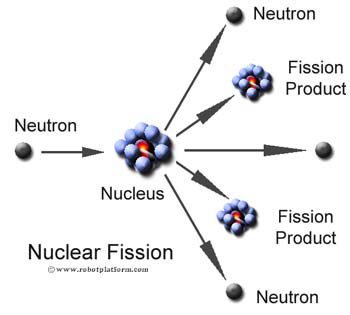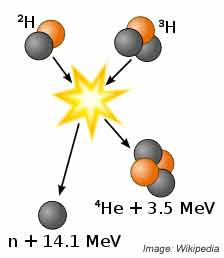Nuclear Power
Nuclear Fusion and Nuclear Fission
Nuclear power in itself is a complicated subject to understand leave away its usage in robots, and hence there are rarely any robots using nuclear power. However there are many advantages of using nuclear power which makes it a suitable candidate for future designs. We are aware that an atom is made of a central nucleus surrounded by electrons and nucleus itself contains protons and neutrons. Nuclear reaction happens naturally, but simulated nuclear reaction is what is useful for us, and there are two types of simulated nuclear reactions; nuclear fusion or nuclear fission.
Nuclear Fission
In this reaction, nucleus in an atom is split into smaller parts when a neutron is fired at a target nucleus in an atom. This hit and split causes several smaller fragments (neutrons and other fission products) releasing energy. When the neutrons released from the target nucleus further hits another nucleus, causes a chain reaction releasing large amount of energy. This chain reaction can be either controlled or uncontrolled. For every two or three neutrons released one neutron should be allowed to strike another nucleus which results in a controlled nuclear fission (Nuclear power). If the ratio is less than one, it dies out soon; if it is more than one, then it results in an uncontrolled nuclear reaction (atomic explosion, or nuclear weapons). Nuclear fusion is generally produced from a fissile material such as Uranium or Plutonium and the heat generated in this reaction can be converted into other forms of energy (including electricity). Usage of nuclear fission in robots is very limited and there are very few robots utilizing the enormous energy generated using this procedure.

Nuclear Fusion
Contrary to Nuclear fission, nuclear fusion happens when two or more atomic nuclei fuse together forming a heavier nucleus releasing or absorbing huge amount of energy depending on the mass of the nuclei involved. Sun and other stars are powered by this very process. A hydrogen bomb is a complex example of nuclear fusion which spontaneously generates a huge amount of energy. Unlike Nuclear Fission, nuclear fusion is difficult to control and usage of power generated from nuclear fusion in a robot (or any device) is a far dream.

Nuclear power is explained here as a source of energy, but not a source of energy for your robots; if you are still a beginner asking “How to build a robot”, you can genuinely ignore this source and check out other options.
Do you have anything to say?
Visit the Forum to discuss, learn and share anything related to robotics and electronics !!








